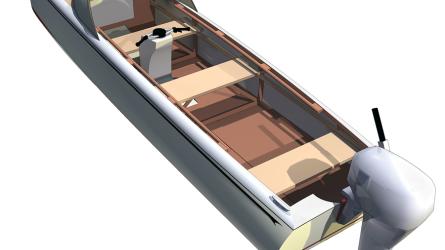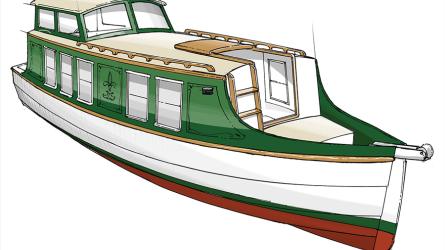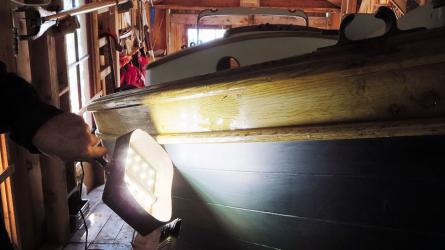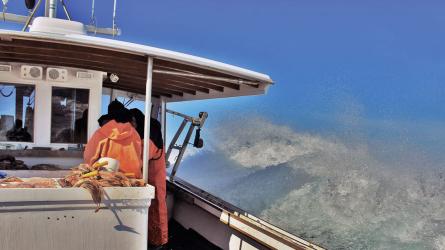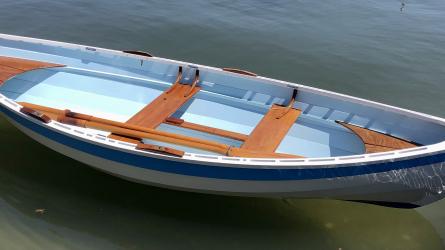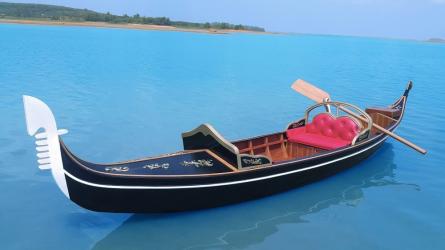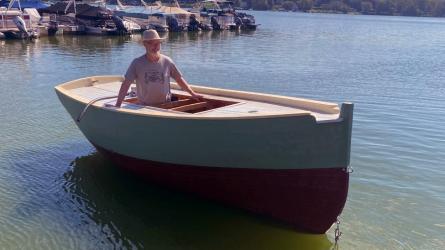March / April 2019
Replacing TALLY HO’s Timber Keel

Early in the reconstruction of a 48′ yacht he rescued from certain destruction (at an initial cost of $1), Leo Goolden realized he could not save the original elm keel. He tackled the enormous task of building a new one by scarfing together two lengths of purpleheart, using the old piece (visible at lower right in the photo) and a new lofting to inform its shape. He is working in Sequim, Washington, but both he and TALLY HO are natives of England, where he intends to return with her after completing the long project and an extended cruise.
When I purchased the 48' LOA 1910 Albert Strange cutter TALLY HO, I knew that she would need to be almost completely rebuilt. One of the things that I hoped to salvage, however, was the elm keel. Not much of this huge beam was visible when I first surveyed the yacht, but what I could see looked to be in reasonable condition, although the bottom face of the keel was joined to the lead ballast keel, the top was obscured by a bilge full of concrete, and the garboard planks covered most of each external side. Nonetheless, as TALLY HO made her way by truck from southern Oregon to my new workshop in Sequim, Washington—over 500 miles away—I was full of naive optimism about the state of her centerline.
A bit of work with a jackhammer soon cured me of my hopefulness. Having removed the concrete from the bilge, I was dismayed to find a huge check down the center of the top face of the timber keel. Even more worrying, though, were the wide checks that I uncovered behind the garboards, as these actually crossed the rabbet to the outside of the boat. As more and more defects became apparent, I realized that the only sensible option was to replace the entire timber.
I was very lucky to find that the local wood supplier, Edensaw Woods in Port Townsend, Washington, had two enormous pieces of purpleheart in stock. Both were 12" × 16", one 26' long and the other 14' long—just the right dimensions to scarf together and match the old keel timber. I had to think long and hard about how to approach the replacement; the structure of the boat was weak and unstable, and I didn’t know whether the hull could support itself under its own weight without the backbone. I added a lot of extra support inside and outside the boat, but I could still only guess what would actually happen when I eased the bottle jacks and let the keel timber lower away from the rest of the hull.
To read the rest of this article:
Click the button below to log into your Digital Issue Access account.
No digital access? Subscribe or upgrade to a WoodenBoat Digital Subscription and finish reading this article as well as every article we have published for the past 50+ years.
ACCESS TO EXPERIENCE
2-for-1 Print & Digital Subscription Offer
For this holiday season, WoodenBoat is offering our best buy one, get one deal ever. Subscribe with a print & digital subscription for $42.95, and we’ll give you a FREE GIFT SUBSCRIPTION to share with someone special.
1 YEAR SUBSCRIPTION (6 ISSUES)
PLUS ACCESS TO MORE THAN 300 DIGITAL BACK ISSUES
PRINT+DIGITAL $42.95
Subscribe
To read articles from previous issues, you can purchase the issue at The WoodenBoat Store link below.
 Purchase this issue from
Purchase this issue from




